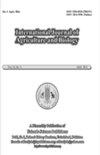{"title":"花生子叶节外植体高频直接器官发生及植株再生","authors":"Abraham Lamboro","doi":"10.17957/ijab/15.1906","DOIUrl":null,"url":null,"abstract":"The efficient plantlets regeneration of peanut is the most important and a primary step to successfully transform gene and apply recently developed genome editing techniques for crop yield improvement. The purpose of this research is to develop protocol for peanut cultivars applying different concentration of hormones for selected peanut cultivars and develop plantlets regeneration protocol. There is no previously reported protocol for the Chinese peanut cultivar N3 and Yu-hua-14. We optimized shoot and root regeneration protocol for two peanut cultivars. Both cultivars showed positive response for the cytokinin plant growth hormone 6-benzylaminopurine (BAP) and thidiazuron (TDZ). The highest shooting rate (97%) was found in a medium supplemented with 4 mg/L BAP and (94.33%) for 1 mg/L TDZ. Hence, more shoot initiation was observed at higher concentration of BAP as compared to TDZ. However, the maximum root regeneration (81%) was found on medium containing 0.3 mg/L 2, 4-dichlorophenoxyacetic acid (2,4-D) and the highest rooting rate (96.33%) was found in a medium containing 1 mg/L α-naphthalene acetic acid (NAA), indicating lower concentration of NAA induce more rooting rate than 2,4-D treatment. In this study, cotyledonary node was used, and this method was found to be efficient and rapid for in vitro peanut regeneration. © 2022 Friends Science Publishers","PeriodicalId":13769,"journal":{"name":"International Journal of Agriculture and Biology","volume":null,"pages":null},"PeriodicalIF":0.0000,"publicationDate":"2022-03-01","publicationTypes":"Journal Article","fieldsOfStudy":null,"isOpenAccess":false,"openAccessPdf":"","citationCount":"0","resultStr":"{\"title\":\"High-Frequency Direct Organogenesis from Cotyledonary Node Explants and Plantlet Regeneration of Peanut (Arachis hypogaea) Cultivars\",\"authors\":\"Abraham Lamboro\",\"doi\":\"10.17957/ijab/15.1906\",\"DOIUrl\":null,\"url\":null,\"abstract\":\"The efficient plantlets regeneration of peanut is the most important and a primary step to successfully transform gene and apply recently developed genome editing techniques for crop yield improvement. The purpose of this research is to develop protocol for peanut cultivars applying different concentration of hormones for selected peanut cultivars and develop plantlets regeneration protocol. There is no previously reported protocol for the Chinese peanut cultivar N3 and Yu-hua-14. We optimized shoot and root regeneration protocol for two peanut cultivars. Both cultivars showed positive response for the cytokinin plant growth hormone 6-benzylaminopurine (BAP) and thidiazuron (TDZ). The highest shooting rate (97%) was found in a medium supplemented with 4 mg/L BAP and (94.33%) for 1 mg/L TDZ. Hence, more shoot initiation was observed at higher concentration of BAP as compared to TDZ. However, the maximum root regeneration (81%) was found on medium containing 0.3 mg/L 2, 4-dichlorophenoxyacetic acid (2,4-D) and the highest rooting rate (96.33%) was found in a medium containing 1 mg/L α-naphthalene acetic acid (NAA), indicating lower concentration of NAA induce more rooting rate than 2,4-D treatment. In this study, cotyledonary node was used, and this method was found to be efficient and rapid for in vitro peanut regeneration. © 2022 Friends Science Publishers\",\"PeriodicalId\":13769,\"journal\":{\"name\":\"International Journal of Agriculture and Biology\",\"volume\":null,\"pages\":null},\"PeriodicalIF\":0.0000,\"publicationDate\":\"2022-03-01\",\"publicationTypes\":\"Journal Article\",\"fieldsOfStudy\":null,\"isOpenAccess\":false,\"openAccessPdf\":\"\",\"citationCount\":\"0\",\"resultStr\":null,\"platform\":\"Semanticscholar\",\"paperid\":null,\"PeriodicalName\":\"International Journal of Agriculture and Biology\",\"FirstCategoryId\":\"1085\",\"ListUrlMain\":\"https://doi.org/10.17957/ijab/15.1906\",\"RegionNum\":0,\"RegionCategory\":null,\"ArticlePicture\":[],\"TitleCN\":null,\"AbstractTextCN\":null,\"PMCID\":null,\"EPubDate\":\"\",\"PubModel\":\"\",\"JCR\":\"Q2\",\"JCRName\":\"Agricultural and Biological Sciences\",\"Score\":null,\"Total\":0}","platform":"Semanticscholar","paperid":null,"PeriodicalName":"International Journal of Agriculture and Biology","FirstCategoryId":"1085","ListUrlMain":"https://doi.org/10.17957/ijab/15.1906","RegionNum":0,"RegionCategory":null,"ArticlePicture":[],"TitleCN":null,"AbstractTextCN":null,"PMCID":null,"EPubDate":"","PubModel":"","JCR":"Q2","JCRName":"Agricultural and Biological Sciences","Score":null,"Total":0}
引用次数: 0
High-Frequency Direct Organogenesis from Cotyledonary Node Explants and Plantlet Regeneration of Peanut (Arachis hypogaea) Cultivars
The efficient plantlets regeneration of peanut is the most important and a primary step to successfully transform gene and apply recently developed genome editing techniques for crop yield improvement. The purpose of this research is to develop protocol for peanut cultivars applying different concentration of hormones for selected peanut cultivars and develop plantlets regeneration protocol. There is no previously reported protocol for the Chinese peanut cultivar N3 and Yu-hua-14. We optimized shoot and root regeneration protocol for two peanut cultivars. Both cultivars showed positive response for the cytokinin plant growth hormone 6-benzylaminopurine (BAP) and thidiazuron (TDZ). The highest shooting rate (97%) was found in a medium supplemented with 4 mg/L BAP and (94.33%) for 1 mg/L TDZ. Hence, more shoot initiation was observed at higher concentration of BAP as compared to TDZ. However, the maximum root regeneration (81%) was found on medium containing 0.3 mg/L 2, 4-dichlorophenoxyacetic acid (2,4-D) and the highest rooting rate (96.33%) was found in a medium containing 1 mg/L α-naphthalene acetic acid (NAA), indicating lower concentration of NAA induce more rooting rate than 2,4-D treatment. In this study, cotyledonary node was used, and this method was found to be efficient and rapid for in vitro peanut regeneration. © 2022 Friends Science Publishers


